Onychomycosis is an insidious disease because many people do not recognize the first symptoms and turn to specialists when the disease is actively progressing. At this stage it is impossible not to notice the signs, the nails begin to collapse, flaking, the inflammation spreads to the skin, the nearby areas become inflamed. In order to take timely action, you need to know what toenail fungus looks like.
Almost two thirds of the world's population has to face the manifestations of a fungal infection. Onychomycosis or nail damage is not just an aesthetic problem; in the later stages the disease begins to cause physical discomfort.
It is difficult to treat onychomycosis, this disease responds better to treatment if you start taking measures in the early stages. And for this you need to know what the nails affected by the fungus look like.
Description of the disease
A fungal disease that affects the nails is called onychomycosis. The fungus penetrates deep into the plate and destroys keratin - the base of the nail plate. Fungal spores enter the intercellular space and begin to multiply rapidly.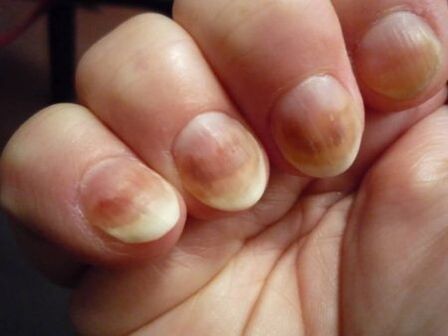 If the infection is not treated, the disease affects the nails and in the absence of adequate therapy spreads to nearby skin areas.
If the infection is not treated, the disease affects the nails and in the absence of adequate therapy spreads to nearby skin areas.
Infection
Fungal spores are present in the environment. They are very resistant to external influences, spores do not die even at subzero temperatures. However, the active reproduction of the fungus is possible only in a warm and humid environment, which is why people are at greatest risk when visiting public baths, swimming pools, gyms.
If there is a person among the visitors infected with onychomycosis, then on the things with which he was in contact, fungal spores remain, which remain active for a long time. And these spores affect the skin and nails of healthy people. To "catch" an infection, it is enough to walk barefoot on the floor, which has fungal spores.

Advice! Particularly dangerous are wooden surfaces - floors, grilles in showers, benches. The fact is that the wood has a porous structure and even complete disinfection is not able to destroy the spores of pathogenic microorganisms.
But, of course, not every "encounter" with the fungus ends in disease. In most cases, the body's immune system successfully fights the infection. But if the body is weakened or a person does not follow basic hygiene measures, then the likelihood of developing onychomycosis increases.
Factors contributing to the development of the disease
In order for the fungus to start its licensing activity, certain conditions must be met. Most often, the elderly are susceptible to the disease, have a weakened immune system, therefore onychomycosis in the elderly is more common than in young people. Risk factors:
- non-compliance with hygiene rules, wearing too tight shoes, clothes and shoes made of synthetic materials;
- the presence of any damage to the skin, even a small scratch, is the "portal" for infection;
- pathology of the endocrine system;
- chronic diseases that weaken the immune system;
- long-term use of drugs, especially hormones, cytostatics and antibiotics.
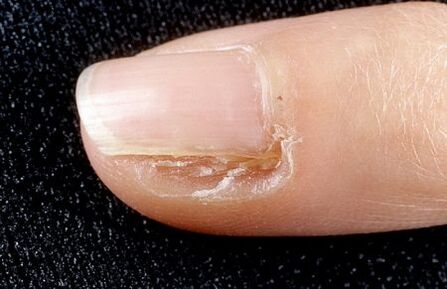
Advice! You can get onychomycosis in a beauty salon by doing a manicure or pedicure. If the master does not pay due attention to the sterilization of the instruments, the knife files can become a source of infection.
Causes of the disease
To date, about fifty species of fungi have been identified that can cause onychomycosis. For this reason, you should not self-medicate. Medicines that are effective for one type of nail fungus can be useless if the disease is triggered by pathogens of another type.
The complexity of treatment lies in the fact that the infection is not localized on the surface of the nail, but under the nail plate. Therefore, the use of external drugs does not always give the expected effect. If left untreated, the disease will continue to progress. In addition, the more the disease is started, the harder it will be to cure.
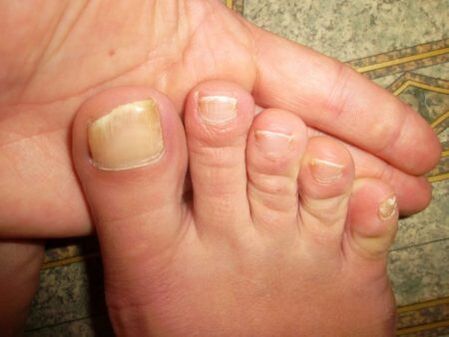
Onychomycosis often occurs on the feet. The infection can affect the nail of the first finger, but over time it can spread to other nails. Fungus on the hands is much less common, but this disease should not be considered rare.
Clinic
The symptoms depend on the shape and stage of the lesion, making it impossible to answer unequivocally the question of what nail fungus looks like.
The most common case
The initial stage is called normotrophic. At this stage, the manifestations are weak, so many patients do not pay attention to them. Most often you can see the following signs:
- loss of transparency;
- the appearance of yellowish spots, most often on the outer edge;
- sometimes there is a feeling that a "cavity" has formed between the nail and the nail bed.
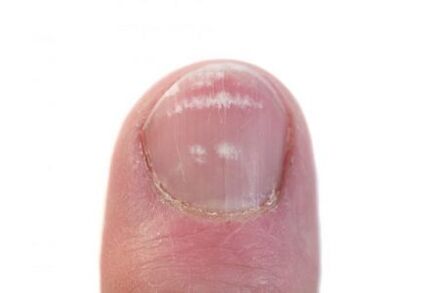
This lesion is called distal-lateral and is the most common. If no treatment is given, the process begins to progress. Subungual keratosis occurs. This phenomenon is characterized by increased growth of horny cells, as a result of which the nail becomes thicker.
Advice! Hyperkeratosis is a normal reaction of the nail to infection. In addition, the deeper the infection penetrates the nail plate, the thicker the nail becomes.
At a later stage, complete damage to the nail plate is noted, signs of dystrophy appear. Gradually, the matrix is included in the process - the place from which the nail grows. At this stage, even the removal of the nail does not work, as the patient's nail plate is already beginning to grow.
Surface shape
In the initial stage of the nails appear whitish spots in this form. Over time, they grow, capturing the entire surface of the nail. The plate becomes loose, rough. If you scratch the nail with a hard object, then the scales begin to separate.
Advice! This form of fungal disease occurs only on the toes, most often on the big toe, less often on the little toe.
Proximal subungual
In this form, the affected nails look like this:
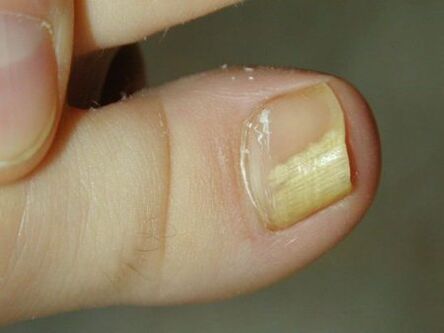
- the tissues around the nail become red and inflamed;
- the roller swells, becomes painful;
- the cuticle begins to separate from the nail;
- dystrophic changes appear in the nail, first grooves appear on the plate, then brittleness appears and in an advanced stage the plate disappears.
Varieties of fungi
The manifestations of the disease also depend on the type of pathogen. Of course, it is possible to accurately determine the type of pathogen only after testing. The external signs are also different, but the symptoms are not diagnosed:
- Dermatophyte. Fungi of the genus Dermatophytes feed on keratin, ie they "attack" the hair, nails and the upper stratum corneum. About 40 species of fungi of this type are known, but onychomycosis causes only about a dozen species of pathogens. The source of infection is a sick person, you can become infected by direct contact or by using common objects. Stripes and spots first appear on the affected nails, then the edge of the nail gradually turns yellow and gradually lags behind the nail bed. The larger the area of the stain, the higher the degree of infection.
- Yeast fungus. These are pathologies caused by fungi of the genus Candida. The cause of this type is opportunistic. That is, in a certain amount of fungus is present on the surface of the skin and nails, but with reduced immunity, the fungus begins to multiply, causing inflammation. When the nails are damaged, the plate gradually thins, turns yellow and then turns brown and lags behind the nail bed. In this type of infection, the folds of the nails are severely affected, they become red, swollen and painful.
Advice! The fungal infection usually develops gradually. Often the disease lasts for years without progressing. But when the nail plate is affected by a yeast fungus, the disease progresses very quickly.
- Forms. The infection caused by molds is localized at the top of the plate without penetrating deep into the plate. Therefore, this type of onychomycosis is easier to treat than others. The first signs of damage are a change in the color of the nail plate. Moreover, the nail acquires an unnatural color, it can become green or black. In the initial stages of the nails, dark spots appear, which gradually develop into spots and over time the whole plate changes color.
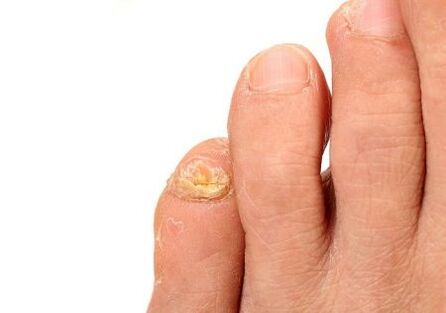
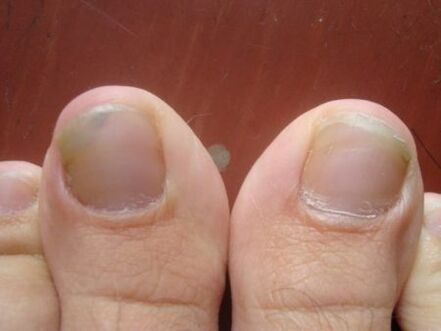
If onychomycosis is not treated, the pathogens are transferred to the skin of the feet, causing mycosis of the skin. In this case, symptoms such as itching, cracks on the skin appear. It becomes painful for the patient to put on shoes and walk.
What should I do?
What should you do if you notice signs of a fungal infection? Self-medication is not worth it. A dermatologist should be seen. The specialist will prescribe tests and make an accurate diagnosis. Parents of children should be especially careful. Of course, in children, nail fungus is not observed too often, but nevertheless such a disease occurs at any age.
Remember that the earlier you start treatment, the easier it will be to deal with the disease. If the fungal infection begins to heal in the early stages, then it will be possible to do with the use of topical drugs - ointments, solutions. But you will have to treat yourself persistently for a few weeks.
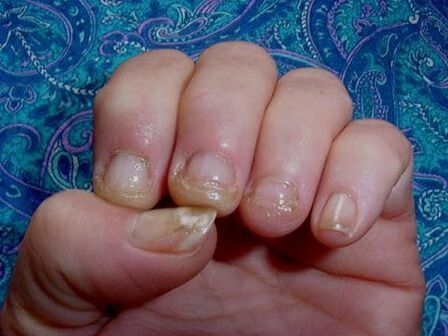
In advanced stages it is necessary to apply not only ointments but also drugs with systemic action, ie tablets. Such drugs are taken orally, from the digestive tract, the active substances are absorbed into the blood and transported into the body through the blood. This will destroy the infection from within.
At each stage of the disease it will be very useful to work to strengthen the immune system. Immunomodulators, if necessary, will be prescribed by a specialist. And the patient himself will have to establish a regime of rest, sleep more and walk daily. You also need to follow your diet. The "favorite food" of the fungus is sugar. Therefore, you should minimize the amount of sweets in your diet as much as possible.
So it will be useful for everyone to know what the nail fungus on the hands and toes looks like. Such knowledge will help to detect signs of the disease in a timely manner and start treatment at the earliest stages. This will allow you to quickly deal with the disease and cope without the use of systemic drugs that adversely affect the liver.
























